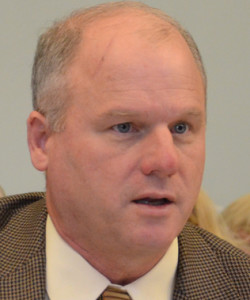By Steve Brawner
© 2015 by Steve Brawner Communications, Inc.
The latest battle over the Common Core was fought Wednesday in the Senate Education Committee, where Rep. Mark Lowery, R-Maumelle, presented a bill that would remove Arkansas not from the Common Core, but from the new PARCC assessment that students take as part of the Common Core. The result is that Arkansas is still part of PARCC.
The Common Core is a set of standards in math and English language arts/literacy, while the PARCC assessment measures progress and compares students in different states. PARCC originally involved 24 states, including Arkansas, which has had a leading role in its development. Other states were part of a different consortium.
Common Core’s supporters, including educators and business leaders, say it provides more consistency and clarity to America’s schools, and that it teaches students more relevant stuff. Before Common Core, we in Arkansas were patting ourselves on the back because scores had improved on state exams while not knowing how those scores compared to students in other states. Maybe Arkansas schools were getting better, or maybe not.
But many others say Common Core represents a federal intrusion. It’s become one of the biggest issues in Republican Party politics, and states have been dropping out of PARCC. Now only nine states are involved, plus the District of Columbia, and for a while this session, Arkansas looked like it might be leaving as well. The House passed Lowery’s bill, 86-1.
In the Senate Education Committee, Lowery argued that the online assessment is full of technical glitches and that it will not protect students’ personal data from prying eyes. The bill’s opponents and the state Department of Education countered that the test is going mostly smoothly, especially considering this is the first year, and that students’ privacy would be maintained.
In the end, the motion to pass the bill died for lack of a second, though senators later passed it with an amendment that weakens the bill nearly to the point of irrelevance. The committee amended the bill, slightly, again on Friday. Arkansas is still part of PARCC. Senators decided it didn’t make sense to end Arkansas’ association with the exam without something to replace it. They’ll hear about this from Common Core opponents.
I asked Lowery if he had any doubts. Not about the PARCC exam, he replied, but he does go back and forth when it comes to Common Core itself.
That’s understandable, because it’s a tough issue. The people who know best, teachers, have varying opinions. I think I’m for it, but I understand why people have reservations.
I’m on firmer ground with these observations.
– The standards themselves are not really the problem. Early in the Common Core debate, opponents argued that the standards are inadequate. They still argue that, but that part of the debate seems to have died down. Too many teachers seem to like them, or at least aren’t raising that much of a ruckus.
– The debate isn’t really about education. This is really the same argument we have all the time about the federal government’s role, with the volume turned up extra high. Much of this is political, and part of it is about President Obama, unfortunately. No Child Left Behind, signed into law in 2002 by President Bush, represents a far greater federal intrusion into education than Common Core does. It says the government can punish entire schools if a single student doesn’t do well enough on a test, and yet there was no public outcry when it was passed. It was a different time, but part of the reason we have Common Core is that everyone had to figure out what to do with No Child Left Behind.
– The federal government never should have gotten involved (which, of course, it inevitably would). Part of the Common Core’s appeal was that it was pushed originally by the National Governors Association and the Council of Chief State School Officers. When the U.S. Department of Education started handing out Common Core-related grants, it became an Obama thing.
– The Common Core came into existence in Arkansas the wrong way, by a vote by the Arkansas State Board of Education during a meeting in 2010. Hardly anyone knew what was happening, and then parents were trying to check their kids’ weird math problems. This big of a change required more of a statewide discussion, if such a thing is possible.
– People who are maddest at the Common Care are maddest at the wrong thing. See the part about No Child Left Behind.


